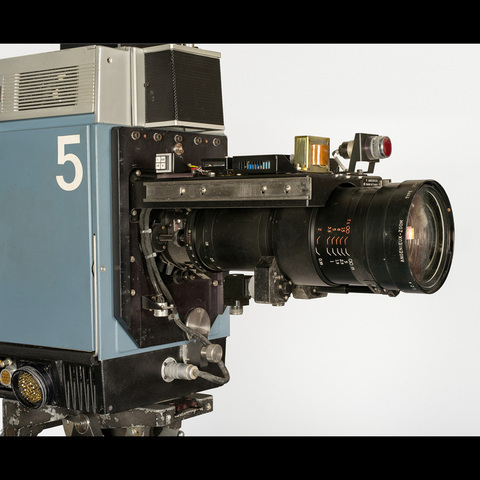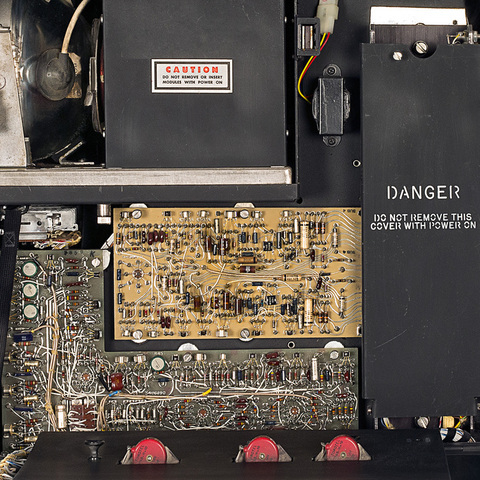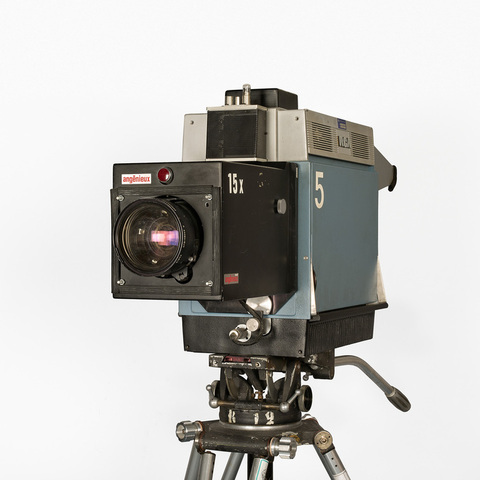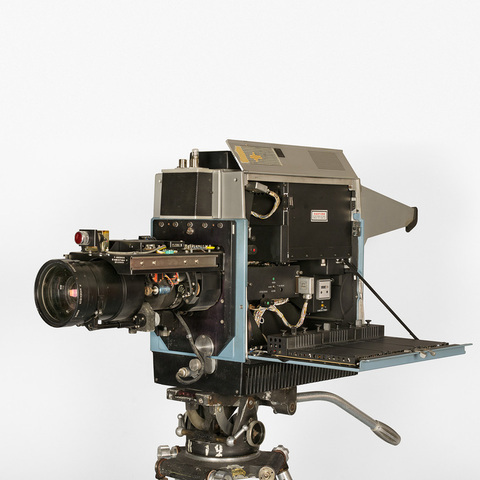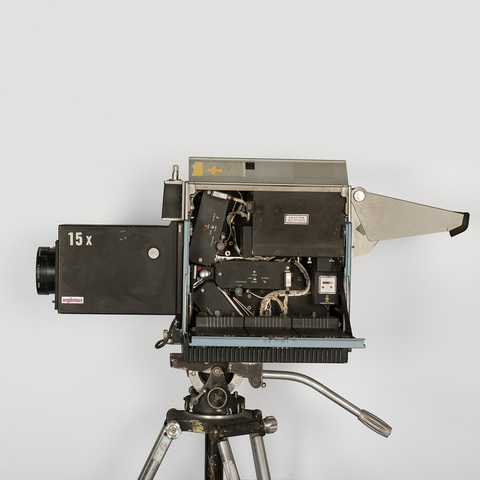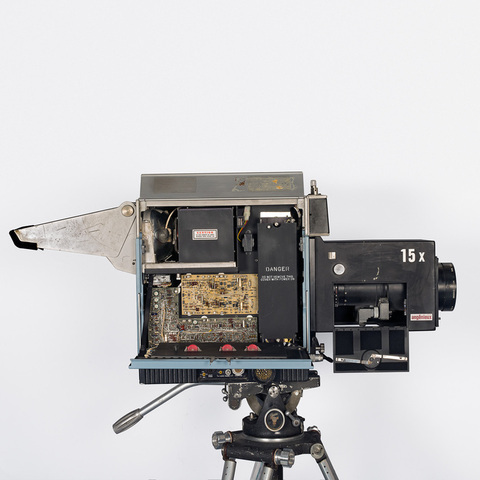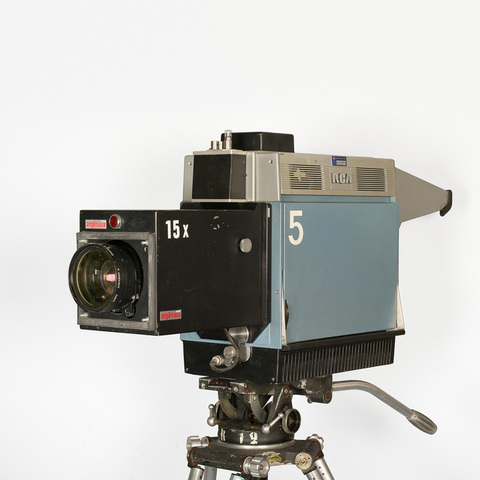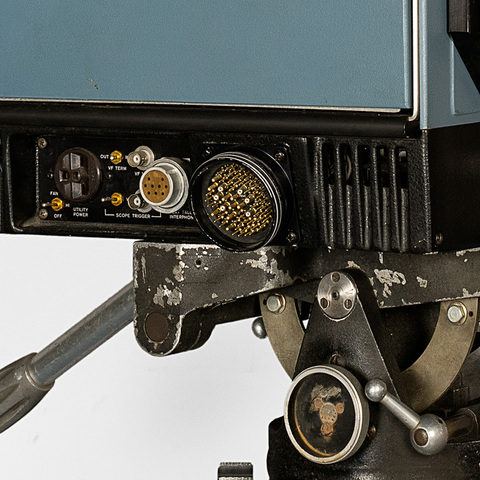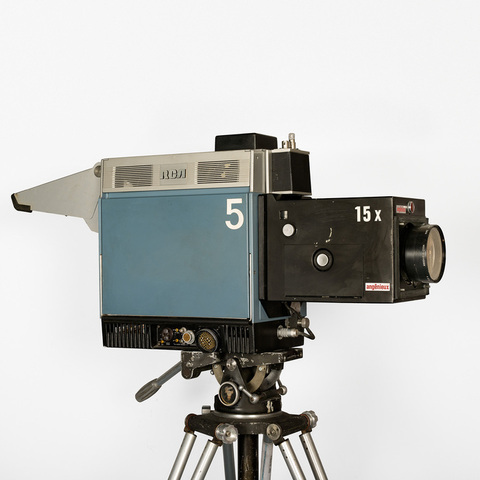Caméra de télévision couleurs
Fiche détaillée
Type de l'appareil
trois tubes Plumbicons ; roue à filtres ; zoom Angénieux motorisé 18 - 270 mm ; viseur à tubes
Auteurs
Informations non disponibles
Fabricants
Etablissements Pierre Angénieux
Saint-Héand
RCA - Radio Corporation of America
Camden, New Jersey
Utilisateurs
Informations non disponibles
Distributeurs
RCA - Radio Corporation of America
Camden, New Jersey
Sujet du modèle
Informations non disponibles
Objectif
Angénieux zoom type 15 x 18 L n° 1363852 F. 18 - 270 mm 1 : 2.4
Taille de l'objet
Ouvert :
Informations non disponibles
Fermé :
Longueur : 118 cm
Largeur : 34 cm
Hauteur : 56.5 cm
Diamètre :
Informations non disponibles
Taille de la boîte de transport
Informations non disponibles
Remarques
Marques : "RCA" ; "RCA Color Camera TK - 44 B MI - 557 258 B1 Serial 07027 117/234 volts 50/60 cycles Camden N.J."
"Il y a trois caméras distinctes : la TK 44 (1967), la TK 44 A (1968) et la TK 44 B (1971). Celle-ci est la dernière version, TK 44 B, la plus aboutie. Elle rencontra un très grand succès aux USA (en Europe le marché était largement couvert par Thomson, Bosch, Marconi, Philips) avant l'arrivée de la TTV 1515 Thomson qui révolutionna le métier grâce à sa liaison sur câble Triax. La différence entre A et B est minime, petits perfectionnements. C'est étonnant que ces trois caméras portent le même numéro : en effet la TK 44 et la TK 44 A sont complètement différentes : la TK 44 est une caméra quatre tubes avec un grand tube Isocon de 3 pouces pour la luminance et trois petits Plumbicons de 1 pouce pour la couleur. Ce sera la dernière caméra à quatre tubes, bien vite remplacée par la version trois tubes TK 44 A, plus facile à fabriquer et à exploiter. Ainsi, la TK 44 marque le passage de la période "couleur expérimentale et approximative" à quatre tubes à la période longue et stable des caméras à trois tubes Plumbicons qui durera près de vingt ans jusqu'à l'arrivée des CCD. Les TK 44 A et B ont été un succès. Ensuite viendra la TK 47, alors la caméra la plus avancée au monde (la première à réglage automatique par microprocesseur)" (Bernard Tichit).
"When RCA came out with the new look TK 12 in 1960 (which became the TK 60 in 1963), they began to feel it was time to replace the TK 41s with a new model, the TK 42, and had an experimental model at the NAB show as early at 1962 as seen below. In essence they wanted to put a TK 41 and a TK 60 in the same camera head. They wanted the TK 60s 4 1/2 image orthicon, so the image broadcast to the millions of still mostly black and white receivers was sharp, but also wanted the kind of great color images that came from the TK 41. With the plan to put the lens inside the TK 42, that did not leave enough room for the three image orthicons and optics from the 41, so they opted for color vidicon tubes. [...] RCA stopped making the TK 41 in 1964, but NBC needed new cameras and they were not happy with the TK 42. [...] The four tube design and lens chatter were big problems. RCA worked to find a way for the TK 42 to match the picture quality of the PC 60 but were not having much luck. [...] The RCA corporate strategy to go all out on the TK 42 was a problem at many levels, including the ego level, but this is where a great back story begins... the stealth, off the books development of the TK 44. RCA was already thinking of the TK 44, but they were still thinking 4 tubes. Under RCA Btroadcast Manager Andy Ingles, Norm Hobson was the management's link and Lead Engineer on the TK 42 - 43. Norm Hobson suspected that soon, there would be something other than the 4 tube TK 44 design needed, so he told Lou Bazin that he "found some money" in another project, and Lou Bazin got started on a 3 tube TK 44 A design long before everyone realized the 4 tube version would not "cut the mustard". [...] 1967 : the TK 44 is a 4 tube camera, using an image Isocon tube in the luminance channel, and was a camera that came out just after the 42 - just before the 44 A in 1968. [...] It wasn't long until the RCA TK 44 A three tube Plumbicon camera was introduced, and the first ones were sold to WBAP in Dallas and delivered in early 1968. The TK 44 As made better pictures and were much more stable. [...] The upgraded TK 44 B, introduced in 1971, was a huge hit. More than 600 were produced by RCA, making the TK 44 series one of its most popular and profitable cameras. Engineers and camera operators liked the TK 44's ease of maintenance, its ease of operation, and the bright and warm color images it produced. Many TK 44s remained in service at TV stations into the late 1980s. Some TK 44s were replaced by the TK 47, which also saw service for up to 15 or even 20 years" (Bobby Ellerbee, The secret backstory of the RCA TK 44, http://eyesofageneration.com/the-secret-backstory-of-the-rca-tk-44/).
